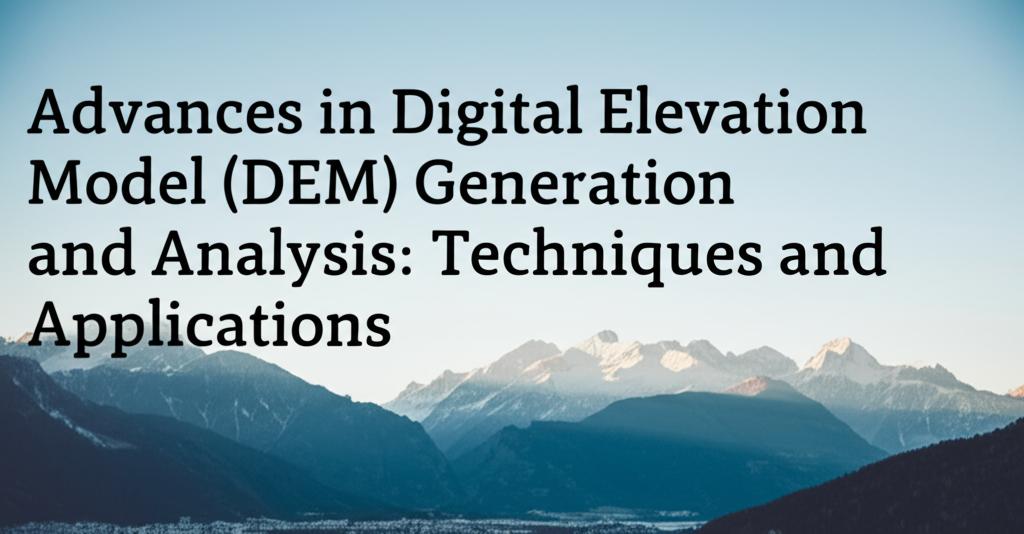Digital Elevation Models (DEMs) are fundamental geospatial datasets, providing a digital representation of the Earth's topography. Their significance continues to grow as advancements in data acquisition and analysis unlock new possibilities across diverse fields. DEMs serve as the backbone for countless applications, from environmental modeling to infrastructure planning.
Evolving Techniques in DEM Generation:The methods used to create DEMs have evolved significantly, offering varying levels of accuracy, resolution, cost, and coverage. Key modern techniques include:
- Photogrammetry: This technique uses overlapping images captured from different vantage points to calculate elevation.
Aerial/Satellite Stereo Photogrammetry: Utilizes pairs or multiple images from airborne or satellite platforms (like SPOT, Pléiades, WorldView, GF-7) to extract 3D information. Automatic extraction techniques have made this process more efficient.
Structure from Motion (SfM) with UAVs: Drones (UAVs) equipped with high-resolution cameras capture numerous overlapping images. SfM algorithms then reconstruct a detailed 3D model of the surface, including terrain and surface objects (creating DSMs, which can be processed into DEMs). This offers high flexibility, resolution, and cost-effectiveness for smaller areas.
- Light Detection and Ranging (LiDAR): LiDAR systems actively emit laser pulses and measure the reflected light to determine precise distances, and thus elevations.
Airborne LiDAR: Mounted on aircraft, it provides highly accurate and detailed elevation data, often considered the gold standard for many applications. It can often penetrate vegetation to map the bare earth (DTM).
Terrestrial LiDAR: Ground-based systems used for detailed mapping of smaller areas or structures.
* Spaceborne LiDAR (Laser Altimetry): Satellites like ICESat-2 provide high-accuracy elevation points globally, which, while not creating continuous DEMs directly due to track spacing, are invaluable for calibrating and improving other global DEMs.
- Radar Interferometry (InSAR): This technique uses phase differences between two radar images (often from satellites like TerraSAR-X/TanDEM-X, Sentinel-1, or missions like SRTM) acquired from slightly different positions to infer topography. It's effective for large-area mapping and works regardless of cloud cover, though accuracy can be affected by atmospheric conditions and surface changes.
- GNSS Surveys: Techniques like Real-Time Kinematic (RTK) and Post-Processed Kinematic (PPK) using Global Navigation Satellite Systems provide highly accurate elevation points for specific locations during field campaigns. These points are often used as Ground Control Points (GCPs) or for direct interpolation in smaller areas.
- Data Fusion and Correction: Increasingly, methods combine data from multiple sources. For instance, lower-resolution global DEMs (like ASTER GDEM or SRTM) are being improved by integrating high-accuracy ICESat-2 altimetry data or using machine learning techniques to correct biases, especially in challenging terrains or urban areas. Sparse modeling and advanced interpolation techniques (like Kriging, TV Minimization, K-SVD) are also used to fill gaps or enhance DEMs generated from incomplete data.
Alongside generation techniques, methods for analyzing DEMs have also progressed:
- Enhanced Resolution and Accuracy: Higher resolution DEMs (down to meter or sub-meter levels) capture finer terrain details, crucial for localized studies like urban planning or precision agriculture. Vertical accuracy remains a critical factor, determining suitability for applications like flood modeling.
- Geomorphometric Analysis: Sophisticated algorithms derive various terrain parameters beyond basic slope and aspect, including curvature, topographic indices (like TWI), and landform classifications, vital for understanding hydrological processes, erosion, and habitat suitability.
- Hydrological Modeling: DEMs are indispensable for delineating watersheds, stream networks, calculating flow paths, and modeling surface water flow, crucial for flood risk assessment and water resource management.
- 3D Visualization and Integration: Modern software allows for immersive 3D visualization and the integration of DEMs with other datasets (like satellite imagery or infrastructure plans) for enhanced analysis and communication.
- AI and Machine Learning: AI/ML algorithms are increasingly used for tasks like automated feature extraction (e.g., identifying landslides or archaeological features), improving DEM accuracy by correcting errors, and enhancing predictive modeling based on terrain characteristics.
The utility of DEMs spans numerous sectors:
- Infrastructure and Engineering: Planning routes for roads and pipelines, assessing site suitability, calculating earthwork volumes, line-of-sight analysis for telecommunications.
- Urban Planning: Visualizing development impacts, planning infrastructure, analyzing view-sheds, managing urban expansion.
- Hydrology and Water Management: Flood inundation mapping, watershed management, modeling water flow and quality, planning reservoirs.
- Environmental Science and Conservation: Modeling erosion and landslides, mapping habitats, assessing solar radiation potential, monitoring glacial changes, coastal vulnerability assessment.
- Natural Resource Management: Precision agriculture, forestry inventory and planning, geological mapping, mining operations planning.
- Disaster Management: Hazard mapping (floods, landslides, volcanic flows), planning evacuation routes, assessing damage post-disaster.
- Archaeology: Identifying subtle man-made features obscured by vegetation or time.
- Military and Defense: Terrain analysis for navigation and mission planning.
- Cartography: Creating topographic maps, contour lines, hillshade relief maps, and 3D perspective views.
The continuous improvement in DEM generation technologies, particularly through UAVs, enhanced satellite capabilities, and data fusion techniques, combined with sophisticated analysis methods, ensures that Digital Elevation Models will remain a critical tool for understanding and managing our planet's surface.

